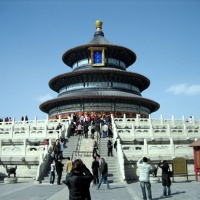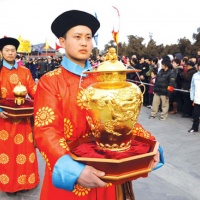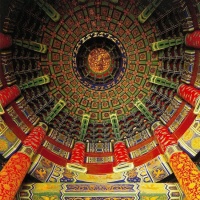- Home Page
- Fact Tours
Our sample tour itineraries of China and China travel packages are sorted by theme and available at competitive prices, you can browse what tours are right for you for your trip to China.
Popular China Tour Packages

Custom Tour Packages to China and Ask Our Experts for Free Enquiry !
- Coach Tours
- Destinations
Beijing, the capital of China. Its art treasures and universities have long made it a center of culture and art in China.
Beijing Top Attractions
Beijing City Tours
Best China Tours with Beijing
Shanghai, the cultural and economic center of East Asia. It renowned for its historical landmarks, the extensive and growing skyline.
Shanghai Top Attractions
Shanghai City Tours
Best China Tours with Shanghai
Xi'an, having held the position under several of the most important dynasties. It is the top destination to explore the facts of Chinese history.
Xi'an Top Attractions
Xi'an City Tours
Best China Tours with Xi'an
Huangshan boasts its culture, beautiful rivers, villages and mountains. It's home to 2 UNESCO World Heritage Sites and the Mecca of photographers.
Huangshan Top Attractions
Huangshan City Tours
Best China Tours with Huangshan
Sichuan is the cradle of the Shu culture, panda, mahjong, teahouse and spicy food. The province ranks first in China by number of UNESCO World Heritage Sites. It is called "the Heaven of Abundance".
Sichuan Top Attractions
Sichuan Tour Packages
Best China Tours with Sichuan
Yunnan, literally means the south of colorful clouds, due to its beautiful landscapes, mild climate and diverse ethnic cultures and traditions, is one of China's major tourist destinations.
Yunnan Top Attractions
Tibet, the nearest land to the sky, is known for its breathtaking landscape, splendid culture, art, buildings, and mysterious religions.
Tibet Top Attractions
Tibet Tour Packages
Best China Tours with Tibet
Explore the lost civilizations by riding a camel! Travel across the Gobi and the desert, and over the high mountains. Our Silk Road tours including different sections of the Silk Road in China.
Silk Road Top Attractions
Silk Road Tour Packages
Best China Tours with Silk Road
Guilin, an internationally-known historical and cultural city, has long been renowned for its unique karst scenery. Its vicinities are the paradise of hiking, caving, rafting, biking and countryside exploring.
Guilin Top Attractions
- China Facts
- China Hotels
- Travel Photos
Attractions
- Legend of Kung Fu - Chun Yi
- Beijing Opera 'Faces'
- Lao She Tea House
- Beijing Hot Pot
- Beijing Opera
- Beijing World Park
- Prince Gong's Mansion
- Beijing Ancient Observatory
- Beijing Aquarium
- Beijing Zoo
- Fragrant Hills Park
- Western Hills
- Peking Man at Zhoukoudian Cave
- Old Summer Palace
- Confucius Temple
- Beijing Grand View Garden
- Beihai Park
- Zhongnanhai
- Lama Temple
- Beijing Hutong
- Ming Tombs
- Tiananmen Square
- Temple of Heaven
- Summer Palace
- Forbidden City
- Mutianyu Great Wall
- Jinshanling Great Wall
- Simatai Great Wall
- The Great Wall
- Badaling Great Wall
Temple of Heaven
As a perfection of Ming architecture, Temple of Heaven (or Tiantan Park) has come to symbolize Beijing. Its lines appear on countless pieces of tourist literature (including your entrance ticket), and as a brand name for a wide range of products from tiger balm to plumbing fixtures. It is set in a 273 hectare park, with four gates at the compass points, and bounded by walls to the north and east. Literally Tiantan is the Altar of Heaven. It originally functioned as a vast altar for solemn rites performed by the Son of Heaven (refers to the emperor in China) who came here to pray for bumper harvests, seek divine clearance, and to atone for the sins of the people. Now, this beautiful traditional temple is the largest complex of ancient sacrificial buildings in China and known as Tiantan Park. It was listed on the roll of the World Cultural Heritage in 1998. For years, it has been one of the hot Beijing attractions and a must see for the foreign tourists. With this complicated mix in mind, the unique architectural features will delight numerologists, necromancers, and the superstitious - not to mention acoustic engineers and carpenters. Shape, color and sound take on symbolic significance: the temples, seen in aerial perspective, are round, and the bases are square, deriving from the ancient Chinese belief that heaven is round, and the earth is square. thus the north end of the park is semicircular and the south en is square (remember that the layout of the Beijing parks places the Temple of Earth on the northern compass point and the Temple of Heaven on the southern compass point).
In October, just before the winter solstice, the Emperor and his massive entourage used to burst through the five gates at Tiananmen and make their way down toward Qianmen. The procession included elephant chariots, horse chariots and long lines of lancers, nobles, officials and musicians, dressed in their finest, flags fluttering. The cortege passed the length of present-day Qianmen Streets in total silence - commoners were not permitted to view the ceremony and remained behind shuttered windows. The Emperor meditated in the Imperial Vault of Heaven, and passed the night at the Hall of Prayer for Good Harvests.
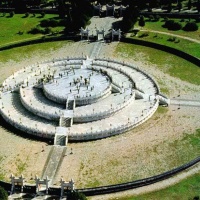 The next day he waited in a yellow silk tent at the south gate while officials moved sacred tablets to the Round Altar. Finally, amid burning of incense, peals of gongs and bells, and incantations by priests, he would ascend the Round Altar and make offerings. The least hitch in any part of the proceedings was regarded as an ill omen, and it was thought that the nation's future was thus decided. This was the most important ceremony - other excursions to the Temple of Earth (Ditan Park) also took place The 5.2-meter-high Round Altar was constructed in 1530 and expanded in 1749. It is composed of white marble arrayed in three tiers, and its geometry revolves around the imperial number 9. Odd numbers were considered heavenly, and 9 is the largest single-digit odd number. The top tier, thought to symbolize Heaven, has 9 rings of stones, each ring composed of multiples of 9 stones, so that the 9th to 27th rings, ending with a total of 243 stones in the largest ring, or 27 times 9. The number of stairs and balustrades are also multiples of 9. If you stand in the center of the upper terrace there is an acoustic effect where sound waves are bounced off the marble balustrades, making your own voice appear louder and you can hear many echoes. (Below is a picture about Heaven Worship Ceremony Performance in Temple of Heaven, the emperor in the the middle of the picture.)
The next day he waited in a yellow silk tent at the south gate while officials moved sacred tablets to the Round Altar. Finally, amid burning of incense, peals of gongs and bells, and incantations by priests, he would ascend the Round Altar and make offerings. The least hitch in any part of the proceedings was regarded as an ill omen, and it was thought that the nation's future was thus decided. This was the most important ceremony - other excursions to the Temple of Earth (Ditan Park) also took place The 5.2-meter-high Round Altar was constructed in 1530 and expanded in 1749. It is composed of white marble arrayed in three tiers, and its geometry revolves around the imperial number 9. Odd numbers were considered heavenly, and 9 is the largest single-digit odd number. The top tier, thought to symbolize Heaven, has 9 rings of stones, each ring composed of multiples of 9 stones, so that the 9th to 27th rings, ending with a total of 243 stones in the largest ring, or 27 times 9. The number of stairs and balustrades are also multiples of 9. If you stand in the center of the upper terrace there is an acoustic effect where sound waves are bounced off the marble balustrades, making your own voice appear louder and you can hear many echoes. (Below is a picture about Heaven Worship Ceremony Performance in Temple of Heaven, the emperor in the the middle of the picture.)
Just north of this, surrounding the entrance to the Imperial Vault of Heaven is the Echo Wall, 65 meters in diameter. A vast improvement over the Chinese telephone, this enables whisper to travel from one end to your friend's ear elsewhere, clearly - that is, if there's not a group tour in the middle. In the courtyard are the Triple Echo Stones - if you stand on Number One and clap or shout, the sound is echoed once, on the third, three times. Should it return four times, you will almost certainly not get a railway ticket that day, or any other day that is a multiple of three.
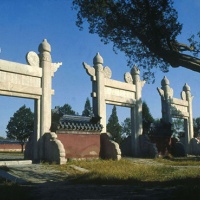 The octagonal Imperial Vault of Heaven was built at the same time as the Round Altar, and is structured along the lines of the older Hall of Prayer for Good Harvests, though it is smaller. It used to contain tablets of the emperor's ancestors, which were used in the winter solstice ceremony.
The octagonal Imperial Vault of Heaven was built at the same time as the Round Altar, and is structured along the lines of the older Hall of Prayer for Good Harvests, though it is smaller. It used to contain tablets of the emperor's ancestors, which were used in the winter solstice ceremony.
The main structure of the complex is the Hall of Prayer for Good Harvests, a magnificent piece mounted on a three-tiered marble terrace. It was built in 1420. In 1880 it was burnt to cinders, and heads rolled in dispensing blame. The supposed cause was lightning - no good harvests that year! A faithful reproduction, based on Ming architectural methods was erected the following year, using Oregon fir as the support pillars. The four pillars at the center represent the seasons, the twelve ringing those denote the months of the year, and the twelve outer ones are symbolic of the day, broken into twelve 'watches'.
Embedded in the ceiling is a carved dragon, symbol of royalty. The patterning, carving and gilt decoration of this ceiling and its swirl of color is a dizzy sight - enough to carry you into the Seventh Heaven. In fact it looks peculiarly modern - like a graphic from a science-fiction movie of a spaceship about to blast into hyperspace. All this is made more amazing by the fact that the wooden pillars ingeniously support the ceiling without nails or cement - for a building 38 meters high and 32.72 meters in diameter, a stunning accomplishment of carpentry. Capping the structure is a deep blue umbrella of tiles with a golden knob and two complementary eaves.
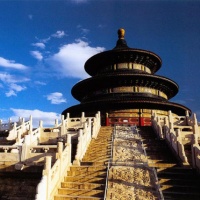 Just as the Forbidden City and the Old Summer Palace. Tiantan was inevitably destroyed to some extent when the Eight Power Allied Force (Japan, British, French, Germany, Russia, America, Italy, and the Austria-Hungary) despoiled Beijing in 1900. According to the soldiers' diaries, their troops seem to be very proud of their feat for doing such a great event in the temple: killed men and raped women (uncountable), and did all they could to marauded the numerous relics there.
Just as the Forbidden City and the Old Summer Palace. Tiantan was inevitably destroyed to some extent when the Eight Power Allied Force (Japan, British, French, Germany, Russia, America, Italy, and the Austria-Hungary) despoiled Beijing in 1900. According to the soldiers' diaries, their troops seem to be very proud of their feat for doing such a great event in the temple: killed men and raped women (uncountable), and did all they could to marauded the numerous relics there.
The Temple of Heaven in Beijing, it should not to be forgotten, is also a park and a meeting place. Tai chi chuan enthusiasts assemble at the gates in the morning and head off for their favorite spots, some practicing snatches of opera en route. There are also nice floral exhibits.
Questions & Comments
Home | About Us | Partnerships | Terms & Conditions | Privacy & Security | Payment Guide | Resource Links| Sitemap
Email: contact@chinafacttours.com, Tel: +86-773-3810160, Fax: (+86) 773-3810333
Copyright © 2008-2020 China Fact Tours. All rights reserved
![]()










